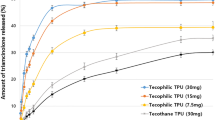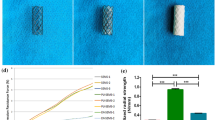Abstract
This study was designed to evaluate the feasibility and efficacy of a dexamethasone (DXM)-eluting, covered, self-expanding metallic stent to reduce tissue reaction following stent placement in a canine bronchial model. We placed a DXM-eluting, polyurethane-covered, self-expanding metallic stent (drug stent, DS) and a polyurethane-covered, self-expanding metallic stent (control stent, CS) alternately in each left main bronchus and left lower lobe bronchus in 12 dogs. The stents were 20 mm in diameter and length when fully expanded. The dose of DXM was approximately 36.7 mg in each DS, but was absent in the CS. The dogs were euthanased 1 week (n=4), 2 weeks (n=4) or 4 weeks (n=4) after stent placement. Histologic findings, such as epithelial erosion/ulcer or granulation tissue thickness, were obtained from the mid-portion of the bronchus, where the stent had been placed, and evaluated between DS and CS. There were no procedure-related complications or malpositioning of any of the bronchial stents. Stent migration was detected in one dog just before euthanasia 1 week following stent placement. Stent patency was maintained until euthanasia in all dogs. Epithelial erosion/ulcer (%) was significantly less in the DS (mean±standard deviation, 46.88±23.75) than in the CS (73.75±14.08) (P=0.026) for all time-points. There was a decrease in epithelial erosion/ulcer as the follow-up period increased in both DS and CS. The granulation tissue thickness (mm) was less in DS (2.63±2.05) than in CS (3.49±2.95), although the difference was not significant (P=0.751) for all time-points. There was a tendency toward an increase in granulation tissue thickness and chronic lymphocytic infiltration as the follow-up period increased in both DS and CS. In conclusion, DXM-eluting, covered, self-expanding metallic stent seems to be effective in reducing tissue reaction secondary to stent placement in a canine bronchial model.








Similar content being viewed by others
References
Miyazawa T, Yamakido M, Ikeda S et al (2000) Implantation of ultraflex nitinol stents in malignant tracheobronchial stenoses. Chest 118:959–965
Shin JH, Kim SW, Shin TS et al (2003) Malignant tracheobronchial strictures: palliation with covered retrievable expandable nitinol stents. J Vasc Interv Radiol 14:1525–1534
Monnier P, Mudry A, Stanzel F et al (1996) The use of the covered Wallstent for the palliative treatment of inoperable tracheobronchial cancers. A prospective, multicenter study. Chest 110:1161–1168
George PJ, Irving JD, Khaghani A, Dick R (1992) Role of the Gianturco expandable metal stent in the management of tracheobronchial obstruction. Cardiovasc Interv Radiol 15:375–381
Song HY, Shim TS, Kang SG et al (1999) Tracheobronchial strictures: treatment with a polyurethane-covered retrievable expandable nitinol stent—initial experience. Radiology 213:905—912
Madden BP, Datta S, Charokopos N (2002) Experience with Ultraflex expandable metallic stents in the management of endobronchial pathology. Ann Thorac Surg 73:938–944
Zakaluzny SA, Lane JD, Mair EA (2003) Complications of tracheobronchial airway stents. Otolaryngol Head Neck Surg 128:478–488
Filler RM, Forte V, Chait P (1998) Tracheobronchial stenting for the treatment of airway obstruction. J Pediatr Surg 33:304–311
Holmes DR Jr, Leon MB, Moses JW et al (2004) Analysis of 1-year clinical outcomes in the SIRIUS trial: a randomized trial of a sirolimus-eluting stent versus a standard stent in patients at high risk for coronary restenosis. Circulation 109:634–640
Park SJ, Shim WH, Ho DS et al (2003) A paclitaxel-eluting stent for the prevention of coronary restenosis. N Engl J Med 348:1537–1545
Lincoff AM, Furst JG, Ellis SG, Tuch RJ, Topol EJ (1997) Sustained local delivery of dexamethasone by a novel intravascular eluting stent to prevent restenosis in the porcine coronary injury model. J Am Coll Cardiol 29:808–816
Strecker EP, Gabelmann A, Boos I et al (1998) Effect on intimal hyperplasia of dexamethasone released from coated metal stents compared with non-coated stents in canine femoral arteries. Cardiovasc Interv Radiol 21:487–496
Colburn MD, Moore WS, Gelabert HA, Quinones-Baldrich WJ (1992) Dose responsive suppression of myointimal hyperplasia by dexamethasone. J Vasc Surg. 15:510–518
Van Put DJ, Van Hove CE, De Meyer GR, Wuyts F, Herman AG, Bult H (1995) Dexamethasone influences intimal thickening and vascular reactivity in the rabbit collared carotid artery. Eur J Pharmacol 294:753–761
Chervu A, Moore WS, Quinones-Baldrich WJ, Henderson T (1989) Efficacy of corticosteroids in suppression of intimal hyperplasia. J Vasc Surg. 10:129–134
Yoon HK, Park KS, Kang SG et al (2001) Influence of dexamethasone-coated nitinol stent on neointimal formation in the canine great vessel model. Korean J Radiol 44:433–440
Hwang JC, Song HY, Kang SG et al (2001) Covered retrievable tracheobronchial hinged stent: an experimental study in dogs. J Vasc Interv Radiol. 12:1429–1436
Coppit G, Perkins J, Munaretto J, Nielsen R, McKinney L, Ulnick K (2000) The effects of mitomycin-C and stenting on airway wound healing after laryngotracheal reconstruction in a pig model. Int J Pediatr Otorhinolaryngol. 53:125–135
Guzman LA, Labhasetwar V, Song C et al (1996) Local intraluminal infusion of biodegradable polymeric nanoparticles. A novel approach for prolonged drug delivery after balloon angioplasty. Circulation 94:1441–1448
Mayoral W, Fleischer D, Salcedo J, Roy P, Al-Kawas F, Benjamin S (2000) Nonmalignant obstruction is a common problem with metal stents in the treatment of esophageal cancer. Gastrointest Endosc 51:556–559
Kurkinen M, Vaheri A, Roberts PJ, Stenman S (1980) Sequential appearance of fibronectin and collagen in experimental granulation tissue. Lab Invest 43:47–51
Blyth DI, Wharton TF, Pedrick MS, Savage TJ, Sanjar S (2000) Airway subepithelial fibrosis in a murine model of atopic asthma: suppression by dexamethasone or anti-interleukin-5 antibody. Am J Respir Cell Mol Biol. 23:241–246
Dixon ER, Weinberg JA, Lew DB (1999) Effect of dexamethasone on bovine airway smooth muscle cell proliferation. J Asthma 36:519–525
Rechavia E, Litvack F, Fishbien MC, Nakamura M, Eigler N (1998) Biocompatibility of polyurethane-coated stents: tissue and vascular aspects. Catheter Cardiovasc Diagn 45:202–207
Ward WK, Slobodzian EP, Tiekotter KL, Wood MD (2002) The effect of microgeometry, implant thickness and polyurethane chemistry on the foreign body response to subcutaneous implants. Biomaterials 23:4185–4192
De Scheerder IK, Wilczek KL, Verbeken EV et al (1995) Biocompatibility of biodegradable and nonbiodegradable polymer-coated stents implanted in porcine peripheral arteries. Cardiovasc Interv Radiol 18:227–232
De Scheerder IK, Wilczek KL, Verbeken EV et al (1995) Biocompatibility of polymer-coated oversized metallic stents implanted in normal porcine coronary arteries. Atherosclerosis 114:105–114
Acknowledgements
The study was supported by a grant (HMP-00-B-31400-00169) from the Highly Advanced National Project, Ministry of Health and Warfare, Republic of Korea.
Author information
Authors and Affiliations
Corresponding author
Rights and permissions
About this article
Cite this article
Shin, J.H., Song, HY., Seo, TS. et al. Influence of a dexamethasone-eluting covered stent on tissue reaction: an experimental study in a canine bronchial model. Eur Radiol 15, 1241–1249 (2005). https://doi.org/10.1007/s00330-004-2564-1
Received:
Revised:
Accepted:
Published:
Issue Date:
DOI: https://doi.org/10.1007/s00330-004-2564-1




